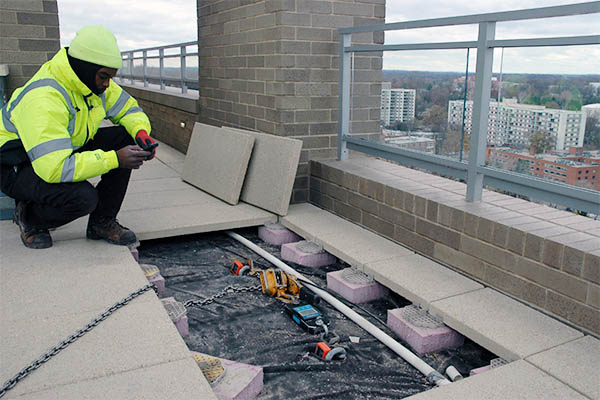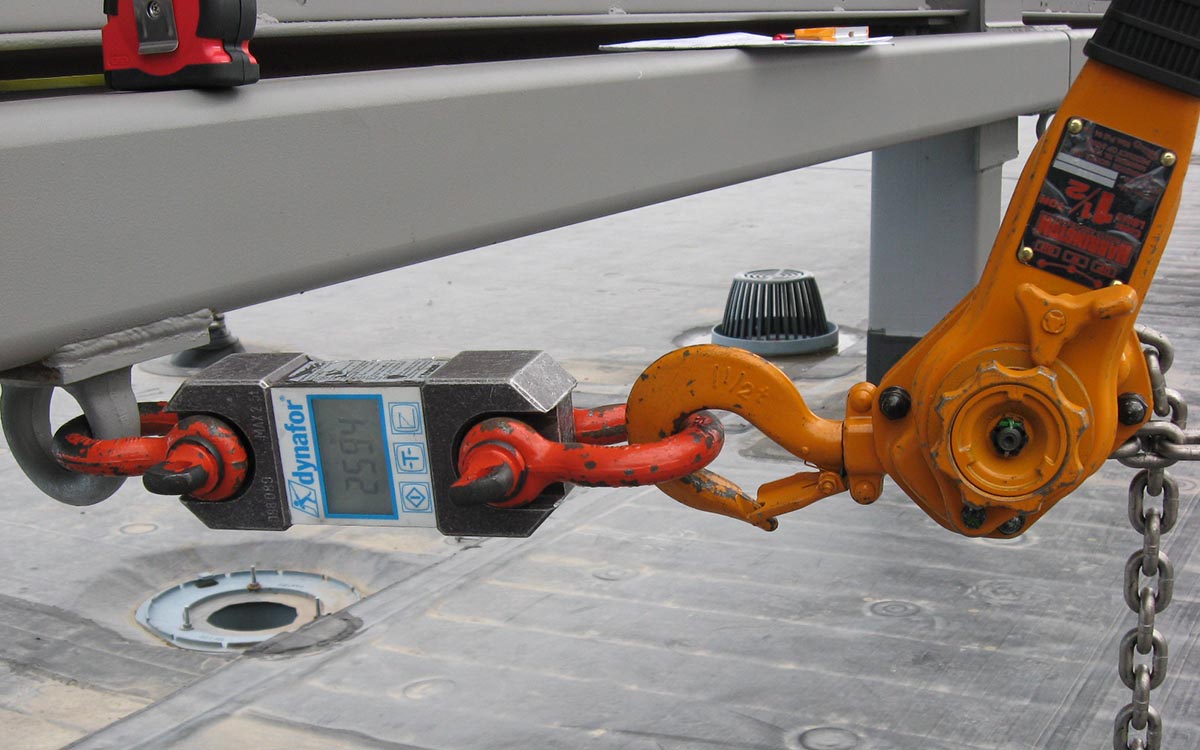Load Testing, Certification & Inspections
Frequently Asked Questions

Safety from the top down.
CLICK HERE to request a quote using our Design Assist Request.
Summit Anchor Co. can perform an on-site review of your fall protection and suspended maintenance equipment to determine if your current equipment complies with safety standards. Factors such as anchor spacing, and edge distance is examined for compliance. Existing equipment must be load tested to verify that such equipment can be certified. Our rooftop review will be supported by a written report with recommendations for any modifications. Contact us for details.
The building owner.
OSHA 29 CFR 1910.27 – Before any rope descent system is used, the building owner must inform the employer, in writing that the building owner has identified, tested, certified, and maintained each anchorage so it is capable of supporting at least 5,000 pounds (268 kg), in any direction, for each employee attached. The information must be based on an annual inspection by a qualified person and certification of each anchorage by a qualified person, as necessary, and at least every 10 years.
Each anchor must be certified by a qualified person, as necessary, and at least every 10 years. OSHA 29 CFR 1910.27 (b)(1)(ii)
However, Summit Anchor Company follows the recommendation of the ANSI A359 Fall Protection Safety Standard, Specifications and Design Requirements for Active Protection System, Paragraph 3.3.1 as follows:
“A Statement shall be made stipulating how frequently the system shall be inspected and re-certified. Periods between recertification shall not exceed 5 years.”
Therefore, all Summit Anchor Co., Inc equipment dedicated to a specific building shall be re-certified by load testing under supervision of a registered Professional Engineer at periods not to exceed 5 years and shall be inspected by a Qualified Person(s) annually and before use.
NOTE: Government agencies such as OSHA use Industry Consensus Standards, such as ANSI A359 as a basis to cite safety violations.
Each anchor must be inspected a qualified person, as necessary, and at least annually. OSHA 29 CFR 1910.27 (b)(1)(ii)
Employers must not allow employees to perform suspended work unless the employer has determined that there are certified anchors capable of supporting at least 5,000 pounds.
OSHA 29 CFR 1910.27 – The employer must ensure that no employee uses any anchorage before the employer has obtained written information from the building owner that each anchorage meets the requirements of paragraph (b)(1)(i) of this section. The employer must keep the information for the duration of the job.
OSHA has provided citation enforcement guidance to regional administrators to examine both employers and buildings owner’s compliance with OSHA’s general industry fall protection systems regulation.
See letter: https://www.osha.gov/laws-regs/standardinterpretations/2017-11-20
November 18th, 2017

When Summit Anchor Co. installs your equipment, you will also have the benefit of receiving an initial certification letter by a P.E., certifying that all the equipment has been load tested and meets load requirements as installed.
When you receive the close out documents, we will provide a cost proposal for the annual inspections which are required to keep your system in compliance with OSHA regulations. We can also test and evaluate suspended access equipment that was supplied and installed by others. Upon completion of on-site compliance evaluation and testing, Summit Anchor Co. will provide you a condition report certified by a P.E. If Summit Anchor Co. supplies your equipment but does not install it, we may still be able to certify the equipment as installed, by examining the construction documentation and following load a test prescription and on-site testing under the supervision of a registered professional engineer.
Anchors must meet certain loading requirements as well be correctly located for access to the work area. Anchorages may include structural elements of the building such as columns and beams that comply with all other OSHA and ANSI requirements. However, to avoid confusion the building owner may opt to have permanent anchors installed to said structural elements to avoid confusion on what exactly has been certified.
Rope descent systems and other suspended access systems can be certified to the OSHA 1910.27 Rope Descent Systems Window Cleaning Safety Standard.
Some examples of other standards and applicable regulations include:
Note: Some states and municipalities (e.g. State of California and New York, City of Chicago) have additional requirements that apply to window cleaning equipment.
Not necessarily. Although the OSHA regulation states that anchorages are required to be capable of supporting 5,000 pounds, that does not always mean that there are enough anchors to properly service the building. Anchor spacing issues required for sound rigging are addressed in the IWCA I-14.1 Window Cleaning Safety Standard. OSHA Subpart D addresses edge distance for anchors. Proper anchor spacing and edge distance is critical to providing a safe working environment.
(See Minimum requirements for rope descent systems.)
(Click HERE to see the interpretation letter)
The manufacturer should be consulted since load capacity may vary. Summit Anchor Co. minimum load capacities are as follows:
Anchors and Rigging Sleeves:
1,250 lbs. Allowable load (Typical. Must be based on hoist capacity in suspended scaffold applications)
2,500 lbs. Test load
5,000 lbs. Ultimate load
Davits for Swing Stage Applications:
1,000 lbs. Allowable load (Typical. Must be based on hoist capacity in suspended scaffold applications)
2,000 lbs. Test load
4,000 lbs. Ultimate load
Davits for Rope Descent System Applications:
1,250 lbs. Allowable load (Typical. Must be based on hoist capacity in suspended scaffold applications)
2,500 lbs. Test load
5,000 lbs. Ultimate load
Monorails for Swing Stage and Rope Descent System Applications:
1,250 lbs. Allowable load
2,500 lbs. Test load
5,000 lbs. Ultimate load
See Summit Anchor Co. specifications for more information.
To ensure worker safety, Summit Anchor Co. systematically tests each davit arm in our facilities to verify that our equipment complies with the load requirements found in OSHA regulations, as well as the A120 and IWCA I-14.1 Window Cleaning Safety Standards. All equipment Summit produces or supplies for suspension load applications has been representatively load tested in our facility.
Additionally, all equipment we manufacture is supported by a test report documentation of raw materials used to make the finished product, so you can be certain that the equipment will meet load requirements when installed correctly.
Summit’s logbook help building manager keep a written record of annual inspections and certification of anchors and other equipment.
IWCA I-14.1 Window Cleaning Safety Standard, Sec. 7.3.2, states: “Log books shall be established and maintained; one that is on file at the building for equipment and anchorages dedicated to the building and one kept by the window cleaner for his transportable equipment, recording each major maintenance activity, the date of the maintenance activity, and signature of the inspector.”
Still have questions regarding fall protection and suspended maintenance requirements, design and equipment?
Call Summit Anchor today and a consultant will contact you.
Regarding fall protection and suspended maintenance requirements,
design and equipment?
Call Summit Anchor today and a consultant will contact you.

Regarding fall protection and suspended maintenance requirements,
design and equipment?
Call Summit Anchor today and a consultant will contact you.
Safety from the top down.
CLICK HERE to request a quote using our Design Assist Request.
Copyright 2024 Summit Anchor Co. | All Rights Reserved